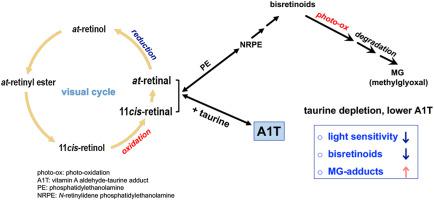Redox Biology ( IF 10.7 ) Pub Date : 2022-07-03 , DOI: 10.1016/j.redox.2022.102386 Hye Jin Kim 1 , Jin Zhao 1 , Janet R Sparrow 2

|
To facilitate the movement of retinoids through the visual cycle and to limit nonspecific chemical reaction, multiple mechanisms are utilized to handle these molecules when not contained within the binding pocket of opsin. Vitamin A aldehyde is sequestered by reversible Schiff base formation with phosphatidylethanolamine (PE) and subsequently undergoes NADPH-dependent reduction. Otherwise inefficient handling of retinaldehyde can lead to the formation of fluorescent di-retinal compounds within the outer segments of photoreceptor cells. These bisretinoid fluorophores initiate photooxidative processes having adverse consequences for retina. Various carrier proteins confer water solubility and maintain the 11-cis-retinoid configuration. Mechanisms for sequestration of retinoid include the formation of a reversible Schiff base between retinaldehyde and taurine (A1-taurine, A1T), the most abundant amino acid in photoreceptor cells. Here we have undertaken to examine the effects of taurine depletion using the transport inhibitors guanidinoethyl sulfonate (GES) and β-alanine. Oral treatment of BALB/cJ mice with β-alanine reduced ocular A1T and the mice exhibited significantly lower scotopic and photopic a-wave amplitudes. As a secondary effect of retinal degeneration, A1T was not detected and taurine was significantly reduced in mice carrying a P23H opsin mutation. The thinning of ONL that is indicative of reduced photoreceptor cell viability in albino Abca4−/− mice was more pronounced in β-alanine treated mice. Treatment of agouti and albino Abca4−/− mice with β-alanine and GES was associated with reduced bisretinoid measured chromatographically. Consistent with a reduction in carbonyl scavenging activity by taurine, methylglyoxal-adducts were also increased in the presence of β-alanine. Taken together these findings support the postulate that A1T serves as a reservoir of vitamin A aldehyde, with diminished A1T explaining reduced photoreceptor light-sensitivity, accentuated ONL thinning in Abca4−/− mice and attenuated bisretinoid formation.
中文翻译:

维生素 A 醛-牛磺酸加合物在感光细胞中发挥作用
为了促进类视黄醇在视觉循环中的移动并限制非特异性化学反应,当这些分子未包含在视蛋白的结合口袋中时,会使用多种机制来处理这些分子。维生素 A 醛被可逆席夫碱与磷脂酰乙醇胺 (PE) 形成隔离,随后进行 NADPH 依赖性还原。否则,视黄醛处理效率低下会导致感光细胞外段内形成荧光双视网膜化合物。这些双维甲酸荧光团启动对视网膜具有不利影响的光氧化过程。各种载体蛋白赋予水溶性并维持 11- cis-类视黄醇配置。类视黄醇的螯合机制包括在视黄醛和牛磺酸(A1-牛磺酸,A1T)之间形成可逆席夫碱,牛磺酸是感光细胞中最丰富的氨基酸。在这里,我们着手使用转运抑制剂磺酸胍基乙酯 (GES) 和β-丙氨酸来检测牛磺酸耗竭的影响。用β-丙氨酸口服治疗 BALB/cJ 小鼠可降低眼部 A1T,并且小鼠表现出显着较低的暗视和明视 a 波振幅。作为视网膜变性的次要影响,在携带 P23H 视蛋白突变的小鼠中未检测到 A1T,牛磺酸显着减少。ONL 变薄表明白化Abca4感光细胞活力降低-/-小鼠在β-丙氨酸处理的小鼠中更为明显。用β -丙氨酸和 GES处理刺豚鼠和白化Abca4 -/-小鼠与色谱测量的双维甲酸减少有关。与牛磺酸降低羰基清除活性一致,甲基乙二醛加合物在β-丙氨酸存在下也增加。综上所述,这些发现支持 A1T 作为维生素 A 醛储库的假设,A1T 减少解释了光感受器光敏感性降低、Abca4 -/-小鼠的 ONL 变薄加剧和双维甲酸形成减弱。











































 京公网安备 11010802027423号
京公网安备 11010802027423号